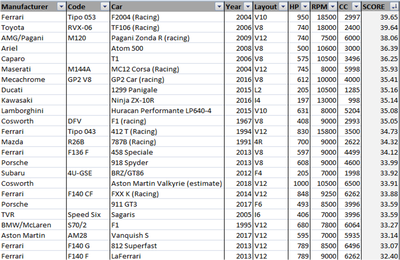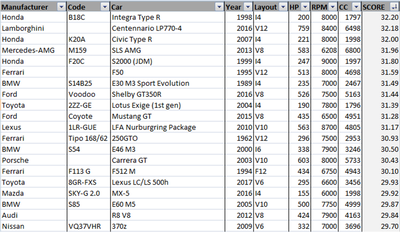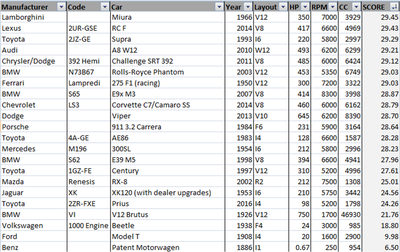A formula to objectively compare engines - N/A engines ranked!
What is the best naturally-aspirated car engine in the world? Some will look to the powerhouse V12s of Ferrari, Lamborghini and Aston Martin, or the exotic V10s of the Carrera GT and LFA. Others will look to American beasts like the LS3 or 392 Hemi.

What is the best naturally-aspirated car engine in the world? Some will look to the powerhouse V12s of Ferrari, Lamborghini and Aston Martin, or the exotic V10s of the Carrera GT and LFA. Others will look to American beasts like the LS3 or 392 Hemi. Or what about the tuner’s favourites like the 2JZ, F20C or Renesis? If only there were a way to properly compare engines without being swayed by fanboyisms and emotion.
Many of you will be familiar with the concept of horsepower per litre. It’s simply the horsepower of the engine divided by its displacement in litres. However, it unfairly favours high-revving engines because the higher an engine revs, the more air it can suck in and the more fuel it can burn.
This is where the formula comes in. It takes the engine’s horsepower, divides it by the cc of the engine and then divides it by its RPM at peak power. Note that peak power RPM is the speed of the engine when it makes the most power whereas redline is just something that the manufacturer sets to prevent the engine from destroying itself.
The result is multiplied by the Constant of Petrolheadedry which is equal to about 2,314,000. This number is calculated so that a perfectly efficient engine (assuming regular gasoline and a stoichiometric air:fuel ratio of 14.3:1) scores 100. Also note that rotary and two-stroke (not that there are any two-strokers in the list right now) have their score halved to reflect the fact that they take in one load of air per revolution (per rotor or cylinder) rather than one load per two revolutions in a 4-stroke piston engine.
So without further ado, let’s look at the list!
The Top

At the very top, we see F1 car engines - first the V10 from the F2004 followed by the V8 from a 2006 car. Both of these are highly-strung engines revving to nearly 20,000 RPM. F1 cars do run on slightly different fuel to regular gasoline, but the energy density and stoichiometric ratio is sufficiently similar to gasoline for it to be a valid comparison.
Next we have the Pagani Zonda R, a slightly more ordinary car with an AMG V12, but still not road-legal. This is followed by the first road-legal cars - the Ariel Atom 500 and the Caparo T1. Both of these rev to over 10,000 RPM and are absolute track monsters. We then see a few more racecars (including a GP2 engine - I would have included Alonso’s Honda F1 engine as a comparison but the formula doesn’t work for turbocharged cars) and some superbikes.
The Huracan Performante is the first vaguely normal car to appear, with its extra 30hp pushing it out in front. Then more racecars including the Mazda 4-rotor from the 787B and the Cosworth DFV engine which powered many F1 cars in the late 60s, 70s and early 80s. A good score for something so old, but I think fuel regulations back then may have been more relaxed.
We then see the first affordeable car on the list: the Toyobaru! It isn’t renowned for its engine, but it makes a good amount of power considering its modest displacement and RPM. Who would have thought that a Toyota GT86 has a better engine than a Ferrari FXX K?
The TVR Sagaris does well to be where it is, considering it was made by a relatively small, financially-insecure company and it’s over 10 years old. Also, note that the 812 Superfast beats the LaFerrari despite the extra displacement it has.
The Middle

There isn’t too much to say here so I’ll just go over the surprises:
- The Ferrari F50 does surprisingly poorly considering its engine is closely derived from the F1 V12 which performs within a few points of the V10 despite being a decade older. The BMW E60 M5 is more loosely F1-derived and it too scores badly.
- Even though it’s a big, muscly V8, the AMG 6.2 engine scores well, beating smaller-displacement engines such as the Audi 4.2 V8 and Ford V8s.
- The E30 M3 beats the E46 M3. This one definitely surprised me.
- The Shelby GT350R only narrowly beats the much cheaper, cross-plane Mustang GT.
- Despite being even more exotic than the Performante, the LFA and Carrera GT don’t make it into the top section.
- The ancient 250GTO and F512 M do pretty well considering their age.
- Both Japanese V6s score relatively poorly considering they are modern engines.
The Bottom

Right at the bottom, we have some of the very first cars to be built. Considering that the Motorwagen was the first car ever, a score of 6.50 is pretty respectable.Then we have the original Nazi-era Beetle and the largest engine ever used in a car, the BMW V12 aircraft engine. These scores are very good for such old cars, although the BMW can only produce that power for a maximum of one minute (normal is 500hp @1500rpm).
The Prius is an interesting case because it’s an Atkinson cycle engine so it takes in less air than a normal 1.8 by changing the valve timing. Then we have the XK120 which is probably extremely under-tuned in order to improve reliability. Remember that this was a car that averaged 100mph for for an entire week back in the early 1950s. Same probably goes for the Century, Phantom and A8 W12 which are more luxury than performance-focused.
The RX-8 does very poorly, but that’s because rotary engines are horribly inefficient. The rotary is great when weight and size are at a premium, but not when you’re trying to save fuel. They can be made to extract far more power with modifications (as in the 787B), but these basically make them racing engines and unsuitable for the road.
The BMW V8s perform surprisingly badly considering how prized these engines are. Same goes for the 2JZ.
However, one of the biggest disappointments was the 1950 Ferrari F1 V12. It scores about 7% worse than the 250GTO which is road-legal and only a decade or so younger.
What’s next?
If there are any engines you really wanted to see on here that I missed, comment them and I’ll run the numbers for you. Be warned that it is difficult to find peak power RPM data for some engines so it may not always be possible.
Also, this formula could be extended to forced-induction engines but it would require knowing the engine’s boost pressure at peak power (this may be different to maximum boost pressure). If anyone knows where you can get data for this, please link!














Comments
Fair comparison i must say! Eliminating both displacement advantage and high rev advantage as factors, all of which increase the engine volume over time.
Any time someone pulls the argument “but that engine is way bigger” or “but that engine revs way higher”, you can apply this formula and get rid of both those issues.
And the dividing rotary by half is something I highly approve of. A 13B should be considered a 2.6L when compared to other four stroke piston engines. Something many people don’t understand. 10/10
The disclaimer here would be that the charts doesn’t actually compare the engines performance against each other but I guess their “normalized efficiency” which mostly takes flow and burn efficiency into account. A little RC motor would go up against 5 liter V8 with this formula.
Yeah one thing it doesn’t compensate for is air:fuel mixture. Some engines tuned for efficiency run lean (probably the Prius), so their score would be underestimated.
Amazing formula but still not something you would judge on engines. I mean the rb26, the laf v12, the cgt and the lfa engines. These are one of the best for a petrolhead (personal opinion) and still though they are scoring a bad result. Not many people would take the toyobaru over the laf engine would they?
Just want to point out that you used the specs of the LT1 v8 instead of the ls3. The ls3 has 430HP and revs at 6200rpm
Sorry, not an expert with American engines here xD. I just tried to find an example of a Chevy N/A V8 to compare with the Mustang and Challenger.
That’s a really good formula, and leads to some pretty interesting results! I tried running the numbers for my own car (Vauxhall Corsa 1.2 VVT) and it came out at 24.14, just less than a Prius. :( At least it’s better than a VW Beetle…
Ah, you just edged out my Suzuki GS500 with a 23,87 :(
Wonder if there’s some way to incorporate reliability into this list… Although i guess there are so many variables it’s hard to quantify. Although the more thermally efficient engines often tend to be higher maintenance
Now that’s a comparison I’ve never seen before…but it makes a lot of sense! The Toyobaru REALLY surprised me.
DOPE POST
What about the original mini and fiat 500?
My Toyota Crysta make 148 hp @ 3400 rpm, it has 2393 cc engine…
So My Score is 42.09
This is for naturally aspirated engines only
Looked it up - that’s a turbocharged diesel engine and therefore cannot be compared using this method.
I wondered too. My car, an Opel/Vauxhall Adam S makes 150hp at 4900rpm from a 1.4l engine so it would have scored 50.60
Then I saw that this formula only applies to N/A cars…
[DELETED]
And of course this formula leaves out peak torque at RPM and engine weight which makes this table … suspect. Also max RPM is missing where this table only shows RPM at peak HP. Another bench mark is torque and HP at 2000RPM. Nice effort but things are not that simple. This table clearly penalizes high power at low RPM? How is that objective? Another thing is that allthough a K ninja is a nice engine … it will perform sh!t in most cars above 1400kg weight, So much for objectivity then?
I get stick as usual … but here is my mini list and with the equation. Eat that. And yeah engine volume is left out because it just does not matter. The LS7 engine is showing where it should be … much better than many other engines.
This is of course a rather simplistic view of an engine that would only be a fair formula if all engines were attached to a CVT and always run at peak power RPM which isn’t the case unless you’re in the early 1990s and part of the Williams F1 team. Perhaps the formula could be refined to include a measure of the width of the powerband like measuring power at half the peak power RPM (which most petrol cars will not exceed during normal driving).
Also, engine weights are rather difficult to come by. It’s reasonably easy to get weights for common swap engines, but not for exotic engines.
Pagination